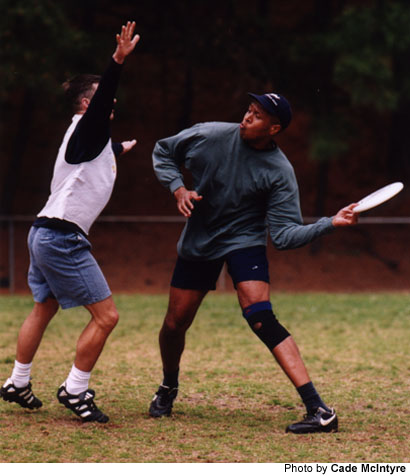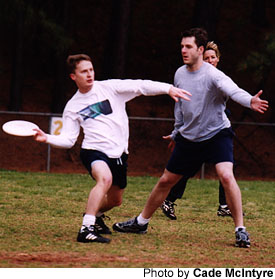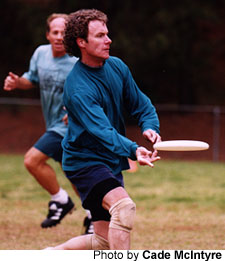
April 11, 2000 — I watched as they filed from parking lot to playing field, each toting some combination of the following: dog, frisbee, child, chair and cooler (full of assorted beverages — some meant for consumption during the game, others for after).
These are the riggings of ultimate frisbee, a fast-paced mishmash of soccer, football … and freeze tag, where frisbee substitutes for ball and “using your dump” is actually encouraged.
For the indoctrinated, frisbees are referred to as “discs,” the game itself simply as “ultimate.” Audibly uttering “frisbee” is a sure way to be outed as a rookie.
There’s a name for those, too. It’s “zero.” And on Saturday, that’s how I was introduced to my team, the aptly named Randall’s Millenium Party, part of the Atlanta Flying Disc Club spring league at the Sequoyah Middle School football field in Doraville.
“We have a zero with us today,” Kerry McFadden said to the team in the pre-game huddle. Instead of groans, my teammates responded with handshakes and smiles. They had all been in my shoes before.
I watched from the sidelines as the game began, and I tried to decipher the action before me. It seemed simple enough. The field is 70 yards long, with two 25-yard end zones. Two teams of seven — typically four men and three women — try to advance a single disc down the field and across their opponent’s goal line.
Once you catch the disc, you must stop. You then have 10 seconds to pass the disc to a teammate. If the disc touches the ground, the defensive team takes over possession.
Those are the basics. Simple, right? Well, the basics don’t cover strategy. They don’t cover lingo.
My unit took the field. As we prepared to “pull,” or kick off, my teammates began to chatter. It all sounded like bells and whistles to me. 
“Who’s cup? Are you cup.”
“No, I’m middle-middle. Are you back-back?”
“I’m back-back. She’s a wing.”
My stare must have been blank. They told me to position myself near the sideline, so a teammate could tell me what to do.
That was defense, a zone defense. There’s also man-to-man.
On to offense. During a break, McFadden took me aside and diagrammed offensive strategy on my tablet. Basically, there are three “handlers” — the person with the disc, a “dump” positioned behind her, and a “swing” off to the side. Everyone else …
McFadden stopped suddenly and yelled out to the field: “Use your dump and swing! Use your dump and swing!” A golden retriever behind us began to bark.
McFadden, 36, of Atlanta, the AFDC’s secretary, has been playing ultimate for five years. She’s a “seven” to my zero. The scale goes up to nine. Thankfully for me, it doesn’t go below zero.
Back to the offense. The remaining four players — with a series jukes, feints and cuts — try to get open.
There’s a lot more that goes into it. But I’m probably not the right person to explain it to you.
Let me say one thing right off: I am not a very good disc tosser. Haven’t really ever done much of it. Never really had the need to move a disc from here to there. Whenever I “have a throw,” as they say, I generally have with me a ball and glove.
As you might imagine, being able to toss a disc is of some importance in this sport. In fact, I’d say it is of ultimate importance. Kind of like what dribbling is to basketball, kicking is to soccer, running is to, well, running.
 It was extremely windy out, and I used that fact quite often as an excuse for my errant throws. Only it seemed to be more windy for me than anyone else. Most of my throwing opportunities came in the pre-game warm-ups. I doubt that occurred by chance.
It was extremely windy out, and I used that fact quite often as an excuse for my errant throws. Only it seemed to be more windy for me than anyone else. Most of my throwing opportunities came in the pre-game warm-ups. I doubt that occurred by chance.
The game moves quickly. And the field seems to expand as the game wears on. Breathing becomes difficult. Ultimate is for athletes.
“It’s a non-contact game, although there will be contact,” McFadden said.
There are no referees, however. Players are responsible for calling their own fouls and violations.
“I really like that aspect,” said Randall Anderson, 31, of Marietta, for whom my team was named. “You have to have an honor to make the right call.”
And that’s the way it has been since the sport’s invention in the late 1960s. It was an activity favored by bohemian college students that emphasized teamwork and fair play instead of cut-throat competitiveness. Though, everyone still wants to win.
Ultimate attracts more than the bohemian college set nowadays. My team featured teachers and architects, artists and engineers.
“You just meet so many people out here,” said Anderson, spring league commissioner. “It’s amazing.”
The people are important, because after the last disc is tossed and the last point is scored, the coolers are opened.
And the real fun begins.
